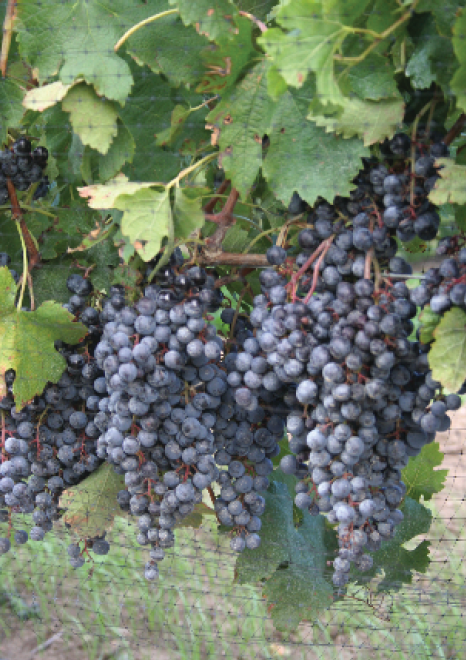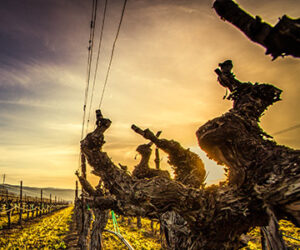 Merlot has become an important red grape throughout world. Merlot grapes, also known as Merlot Noir in Bordeaux, have been used to soften wines made from Cabernet Sauvignon for many years. Merlot produces lots of bouquet, savor, and softness, which decreases the firmness of the Cabernet grapes and makes the wine drinkable sooner.
Merlot has become an important red grape throughout world. Merlot grapes, also known as Merlot Noir in Bordeaux, have been used to soften wines made from Cabernet Sauvignon for many years. Merlot produces lots of bouquet, savor, and softness, which decreases the firmness of the Cabernet grapes and makes the wine drinkable sooner.
The demand for Merlot has caused this grape to be planted in areas that previously had been stereotyped as unsuitable for it. Merlot grapes thrive in cool areas such as the Yakima Valley of Washington state, Long Island, N.Y., and some areas of British Columbia. However, there are many examples where Merlot thrives in hotter climates, such as at Duckhorn Vineyards and Beringer Vineyards, both in St. Helena, Calif. Cooler climates tend to produce grapes with lower pH. In some cases a pH more than 3.6 can cause the grapes to turn brown and not age well.
Normally Merlot has a red raspberry bouquet and flavor with half the tannin (the element that makes you pucker) of a Cabernet Sauvignon. This is why Merlot is such a popular varietal today. The wine is softer and easy to consume.
The Merlot that we make at the Yakima River Winery in Washington’s Yakima Valley is a big, extracted, full-bodied wine. We age half of the wine in two-year-old barrels and half in new barrels for two years. The Yakima Valley Merlot has a red raspberry and brown spice (nutmeg-clove and cinnamon) flavor.
To make a wine like ours the grapes need to be very small, with a sugar level of 23.5 to 25 °Brix with a pH of 3.2 to 3.4 and a total acid of 0.78. The higher Brix level gives the wine a richer mouthfeel than wine made from grapes at 22 °Brix. If your pH is too high — 3.7 to 4 — you might want to blend in 20 percent Cabernet Franc or Cabernet Sauvignon; this will lower the pH.
Don’t worry about the sugar as much as the pH. The sugar only makes alcohol. Also, you can add sugar to your juice because you are not bound by law as are commercial producers.
Make sure you remove all stems from your grapes because stem tannin will make your wines bitter and taste stemmy (a green taste). Never allow juice to contact the grape stems.
Try to ferment your Merlot at 82 to 86 °F (28 to 30 °C). This will give you good color from the skins and a rich mouthfeel.
When the fermenting must (skins and juice) reaches 6 °Brix, add malolactic culture and finish fermentation. Sometimes the malolactic fermentation takes a long time to finish, sometimes not until the end of the following summer. Don’t try to rush into bottling. If you do, the bottles might explode.
Make sure all the wines you blend together have finished malolactic fermentation before you bottle. I like to finish fermentation before I blend, and I blend only when the pH is too high, 3.7 or higher. The best grape to lower the pH in our area is Cabernet Franc, but any high-acid grape will help.
Malolactic culture converts malic acid (the type in green apples) to lactic acid (the type of acid found in milk). This converts the sharp taste in your wine to the softness of milk, thereby softening your wine.
Push down the skins during the fermentation three times a day to keep the cap (fermenting skins) wet. A good yeast for a complex Merlot is Pasteur Red, while EC1118 creates a cleaner, fresher finish. It’s best to stay away from Montrachet, because it produces hydrogen sulfide.
I like to keep Merlot on the skins for 14 to 21 days during fermentation. When fermentation is complete, keep your must covered with carbon dioxide. One indication that fermentation is complete is when all the skins sink and no more carbon dioxide is given off. But probably a more reliable way to tell is to use a pill test, taste the wine, or test the Brix with a hydrometer. Press and settle out, then rack within 24 hours to your oak barrels if you have the quantity or to carboys if you lack sufficient quantities (settling is when all the solids drop to the bottom of your carboy, and racking is when you remove all the clear wine from the solids).
If you use oak chips, use only one-quarter pound per gallon (0.11 kg per 3.8 L) or less. If you use older barrels, make sure you rinse them out. Then soak them in a mixture of warm water and a cup (0.24 L) of citric acid per barrel until tight (no leaks). Make sure you thoroughly rinse the citric acid with water. Soak oak chips in water overnight, then strain and add oak water slowly to the wine per your tasting preference.
If you choose to fine, treat or fine the finished wine when you are sure the malolactic fermentation is complete. Just before bottling is a good time to use egg whites.
If you live in a northern climate, put the wine outdoors so that it reaches a temperature of 26° F (-3° C) or a little below that. Plastic carboys work better than glass for this cold stabilization. Glass carboys might break. This process removes the cream of tarter so no crystals form in the bottle. Cold stabilization can take up to three weeks at 26° F (-3° C), although some winemakers feel this is excessive and not a good idea for reds. Chill reds for three weeks at 28° F (-2° C).
Use one potassium metabisulfite tablet per gallon of wine at this time to prevent oxidation. As a rule of thumb, less SO2 is needed the lower the pH. If the wine is too tannic for your taste, use a small amount of Knox gelatin to soften the tannins. Dissolve the gelatin in warm water and mix well with the wine. Rack off the solids at the end of cold stabilization.
Fine-Tuning the Wine
There are many variations you can make in your Merlot. Try fewer days on the skins during fermentation to make your Merlot softer or more days on the skins to make it heavier. You can also experiment with punching down more or less often, aerating, using cooler or warmer temperatures, and picking the grapes earlier or later. Try different yeast strains. Each yeast strain has a different flavor (each yeast produces different esters).
Each forest of oak produces different flavors as well, so try the different oaks that you might find in your favorite home winemaker’s supply house, and don’t forget that commercial wineries sell off barrels almost every year. So look for a winery in your area that will sell you two- or four-year-old barrels. Sometimes you can purchase used barrels for $50 or less. Smell the barrels before you buy them. If they smell like rotten eggs or mold, do not purchase them. You might be better off using oak chips than barrels if your production is less than 60 gallons (228 L).
A Note About Grapes
As a home winemaker you might not have very good control over how your grapes are grown, but here are some things to look for when you buy your grapes.
Grapes should be clean, sound, and overall ripe. Each grape in a cluster should be a full-colored deep purple. Do not accept mold or dehydrated grapes. If you have dehydrated grapes in the batch you have purchased, remove them; do not try to save them. These dehydrated grapes will give your wine a prune or raisin taste and not the nice raspberry flavor you expect from Merlot.
All grapes should be smaller than a nickel; the smaller the grape the more intense the finished wine will be. If you see the vineyard, look for grapes that are not overwatered. At harvest the ground under the vines should be very dry. This stresses the grapes into producing more sugar and flavor. Also check out the condition of vines, crop load, trellising, weeds, and the overall health of the vineyard.
Home winemakers should be able to locate Merlot grapes over much of the United States and Canada. Also Merlot concentrate is readily available at home winemaking stores. Some nurseries grow grapes for the cuttings to make plants from and will sell the grapes to home winemakers.Look in the phone book. Not all nurseries sell grapes. Trade associations such as the California Wine Grape Growers or the Washington State Wine Grape Growers are also good leads for locating Merlot grapes.







